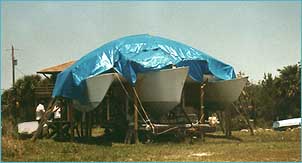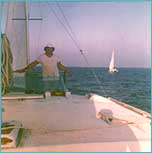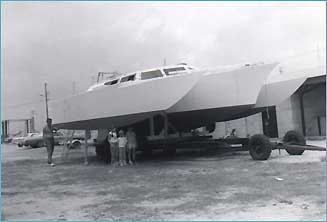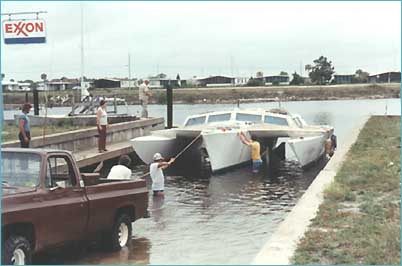
For 13 years the bright blue tarp (standing higher than most coastal vegetation) was used as a navigational aid by Oyster Bay boaters. 1983 photo.
Oyster Bay Eyesore
by Frank Howard
April 18, 1995
For several years now one man's vision has been a ugly eyesore for the residents of Oyster Bay, Florida. The eyesore was (I say was, for it is now gone!) a very rotten wooden boat.
Of course it was not always rotten nor has it always been in Oyster Bay. Then, how did it come to be such a rotten eyesore?
The boat itself has a somewhat interesting history. It was a 35.5 foot ketch-rigged Trimaran sailboat built in White Bear Lake, Minnesota. in 1964-5. It was hull number 191 from an Arthur Piver design called Lodestar. The main cabin was 14 by 16 foot and housed two double berths, a galley (kitchen) with stove and oven and an ice-maker refrigerator. The aft cabin contained one double berth. A large 12V generator and bottled gas powered all these items. The head contained both built-in and portable potties. It also had facilities for showers. There were also spaces for three more bunks! The vessel was built to be lived aboard by an engineer and his young family. The boat, GYPSY, was documented at 11 plus tons in 1967 with Minneapolis as it's home port of record and promptly put to sea.
Or as it really was, put into the river as the family supplies and belongings were put aboard and the vessel began a very nice cruise down the river system into the Mississippi and down river to New Orleans, La. While temporarily employed there the family continued their live-aboard on the boat. Dockside life was interrupted more than once as the boat was utilized as a race boat. For this the family had to strip it down to racing trim by removing some of the normal household "extras".
 |
|
Photo of Gypsy in 1969 tied to the dock at St. Marks, Florida. |
The boat proved itself quite fast but it was the racing that brought about it's first damage. During one of those races there on Lake Ponchartrain the boat "threw" it's 41 foot mainmast into the lake breaking it and ruining the special racing sail. Big loss. After a new mast the boaters sailed off to other employment. Home base was then moved to Gulf Port, Miss. And still later, Mobile, Ala. Then came Pensacola, Fla. No more racing!
A more permanent employment spot became available in Tampa and off across the Gulf the family sailed. The job did not pan out but news of a similar position at the Florida State University prompted a sail up the coast to St. Marks, Fla. (1969). There, the boat had to be left and a house near the school found. As the new job quickly became an almost double-time job, the boat was more neglected. After it was struck in the side (perhaps as a local resident said, "by a barge...") it filled with water and could no longer be used until major repairs were completed.

|
|
Annual hull scrapings were scheduled with the tide....not necessarily daylight. 1970 photo of Gypsy in front of the Shell Point Restaurant. |
It was rescued by being sold to a new owner. The crushed side of the hull was replaced and many of the furnishings replaced. Of the hardware only the generator was completely lost. (The bedding and most of the loose furniture had been tossed overboard by vandals.) The radios and electronics were stolen when the newly purchased boat was vandalized a second time. Even the 1 inch heavy anchor rope was ruined when about 50-75 ft. was cut from the center of its 250 ft. length!
The boat was moved from St. Marks to Shell Point in Dec. 1969. A boat 22 ft. wide could not be pulled out onto the beach just anywhere. In fact not one marina in the immediate area would pull it. Repairs had to be completed on the underwater portion of the recently crushed hull before it could be a regularly sailed. The fin under that hull was damaged causing the fin to act more as a set of brakes than a sailing aid. (An interesting anecdote told by the owner concerned sailing the boat out to the flats prior to repairs. "Other sailors were, of course, unaware of the underwater condition of the boat, so one of the boat owners sailed his boat in such a manner as to show he could sail circles around the big Trimaran! It was embarrassing, but still humorous as that sailor never got to see the boat weeks later when it was recording over 20 knots with the same sails up...")

|
|
Grinning Captain at the helm, 1974. |
The owner decided to work on it over on the flats out from Live Oak Island at extreme low tides. Since Shell Point residents were accustomed to "rescuing" sailors who ran aground, the owner was much chagrined by the number of folks who took the time to come out and offer to "take the family" ashore while the men folk waited with the stranded boat. They could not accept that the boat had been intentionally grounded on top of sheets of plywood. But the hull was repaired in time for the return of the tide on the second morning.
The boat was used mostly for day sailing and short runs along the coast. Eight days out was the longest trip during the next couple of years. Tho' professionally built the fiberglass covered plywood vessel was not well built and internal rot was a constant problem. Many fading surfaces had been left without sealant when put together - an invitation to rapid rot in our climate. By 1972 it had to be pulled out of the water and some major repairs completed on the main hull. The mast had split during a bad thunderstorm right in front of the restaurant. The owner, a former boat builder, decided to do the repairs himself.

|
|
Pulled for maintenance in 1972 and parked beside the Shell Point picnic tables. |
With much help from the marina personnel and family members (and with "George" handling the old tractor at the Shell Point marina - he was the only one who could do that job as the tractor had no brakes at all!) the boat was out of the water for the first time since 1966. It remained parked in front of the Shell Point station while refurbishing continued. Back in the water in a month it awaited a new mast. A 41 foot hollow 5 by 9 inch spruce mast was finally installed.
But not until after the hurricane of that year. There was much jockeying of boats in the basin that night. The boat was normally tied at the end of the covered marina. But that night the boat owner, the marina owner and several others had to use axes to chop holes in the marina deck as the wind blown tide began to recede with the covered marina now out over the tops of it's retaining pilings. Getting holes in the marina decking allowed the marina to set back down on the water but soon "pointed" to another problem. Displaced pilings arising from the water were aimed at boat hulls! That wild night finally ended with GYPSY being "snaked" across the wind swept basin to avoid being impaled on those now emerging pilings. GYPSY escaped with only minor damage. Others were not so lucky.
The next several years were nothing but good family sailing. Except, as the owner puts it, "wooden boat upkeep". This boat had arrived at Shell Point marina as the first sailboat in the, then new, basin. There was another Trimaran, a well maintained 24 footer, over in the canal with the other half dozen or so sailboats of Shell Point.

|
|
Pulling into the slip in 1974 after a good day of sailing. Shell Point covered marina is in the background. Slips in the basin had recently been expanded to encircle half the basin and ended directly behind the restaurant. Gypsy, at 22 feet wide, moved from the end of the covered marina to the "last slip". |
In those early days little was kept locked. There was only the little fleet of for-hire fishing boats tied up in the center of the basin. This soon changed as the marina expanded half way around the basin to meet the demand from the explosion of sailboats coming on the scene.
Once again, equipment was stolen from the boat. The 8 foot dinghy was stolen twice, but the marina personnel and the Sheriffs department quickly recovered it both times. The wheeled beach launcher for a 14 ft. day sailer (also kept nearby on the basin bank) was never recovered.
But good sailing continued with short mid-week trips up and down the coast. The owner was now working 10 hour days and many weekends. So sailing time interfered with boat up-keep time. On one quick sail over to pick up friends on Alligator Point the boat struck a floating piling which damaged two of the hulls. It lodged against the rudder damaging the transom badly. Once again, low tide was utilized to patch the boat to day sailer condition again, but it would have to come out of the water for permanent repairs (A whole new transom!).
Disaster strikes. The owner was preparing a cradle on a 32 foot trailer bed on which to pull the boat when he fell between the trailer's tandem wheels. A badly crushed knee. Metal knee replacement parts, several months and several surgeries later the owner is around on crutches ready to supervise as friends and family once again pull the boat up the marina ramp.

|
|
Gypsy is pulled at Shell Point in 1982 for repairs. Who would have guessed these were Gypsy's last moments in the water? |
It is 1985 and repairs go very slowly as the interior box frames must be sawed out and replaced. A complete new stern and transom are built ready to be replaced onto the hull. But, once again hurricanes strike.
During Hurricane Kate a house struck the boat. Yes, a house! Since the boat had been perfectly usable as an air-conditioned cabin, the galley stove and refrigerator had been conveniently relocated down on the ground level trailer bed under the overhanging outer hull. This arrangement made everything instantly ready and allowed the owner to work every available bit of free time. But the hurricane waters had removed all the equipment at ground level. The house which moved across the lot further damaged the boat hull and removed the temporary cover which had been built over the boat.
The owner was not able to recover from these losses while coping with many other losses at his Tallahassee home. The boat languished there for some 3 or 4 more years. Although the owner still viewed the needed repairs as a retirement project it was to be another 2 more years before retirement. Sadly, the decision was made to sell the boat before it went completely. A resident of Oyster Bay called to inform the owner the boat advertised for sale was no longer there!
What did he mean, "not there"? A quick trip to the lot showed exactly that, the boat was gone! The Oyster Bay neighbors thought it had been sold. How could a 35 foot boat in really bad condition be stolen. The Sheriff's department found it very quickly as it had been towed only as far as the Shell Point Marina. The thief maintained he had been told the boat was abandoned. A complete set of picnic table and benches (owner's initials and a design carved into the bottoms) along with tools and the equipment from the 3 small day sailer boats used by the owner's family were all gone. Flare guns, sails, life vests, all of it gone. Only a single day sailer sail was ever recovered.
 |
April 1995....a chain saw and two days work....Gypsy is gone. |
Although the person then in possession of the boat was to pay for it, it was never paid for and months later was mysteriously moved back to the lot one night. In the move back, the old trailer tires blew out causing the trailer to break. The boat dropped so hard into it's cradle the keel and the cradle broke. A fellow boat builder remarked "It would surely be a labor of love to even consider beginning to rebuild this..."
Attempts to exact some payment for the losses failed. Though by now retirement had arrived for the owner, so had major surgery and a bout with cancer. The boat was beyond all help and 1995 would still find the owner not yet recovered enough to work. At this point the owner realized it was no longer reasonable to consider repairs and surrendered the documentation papers to the Coast Guard. GYPSY was dead and awaiting "burial".
Finally, in April of 1995, family members joined in dismantling what the most recent vandals and rot had left of the old vessel. The few remaining pieces of hardware were removed and the boat sawed up. What had taken many hours to build and even many more to keep in repair was sawed up in less than two days.
The "beached whale" eyesore of Oyster Bay was finally gone. Though many openly applauded the new sight, there was a tear or two for the circumstances that caused a fine old vessel to arrive at such a fate.
Other articles about the Wakulla County area:
- Shell Point, Florida - Finding Pottery.
- Wakulla County Civil War Action
